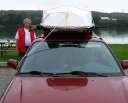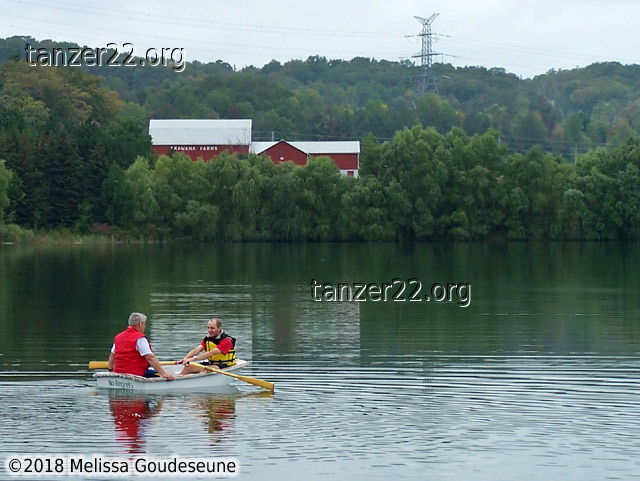Launch
With the weather in Ontario turning towards the chilly side of things,
a weekend in September was chosen for the inaugural launch of No Regrets.
Here is the dinghy on the roof rack (a Yakima model, borrowed from my
friend Peter in photo 3).
The dinghy is lightweight, but still awkward to carry solo. Two people
made moving it around easier.
An overview of the dinghy, showing the name on the stern:
Swordfight
As usual, give two guys implements resembling weapons, and see what
happens! The second photo shows the oars in a more calm locale.
Temporary Oarlock Clamping
Before permanently installing the oarlock sockets, I wanted to test the
dinghy with the sockets clamped in place. This would allow them to be
repositioned if necessary, before drilling any holes.
Splash
The dinghy splashes for the first time! Unfortunately, there was no
champagne on hand.
The oars were placed in the sockets, and then I tried to figure out where to
put my knees. 6'6" is a small dinghy!
Rowing
Rowing around on Lake Kelso. Even with 140 lbs on board, the dinghy floats
very high in the water.
During the rowing testing, one of the wood pieces holding the oarlock
socket in place, snapped. A bit of careful rowing brought the dinghy
back to shore, to install the oarlocks properly with hardware.
Oarlock Installation
The oarlocks were installed in the position noted on the plans, after all.
The blue tape flag visible in photo 1 served as an indicator to
prevent drilling too deeply.
Back into the water, the oars behaved better when properly anchored. It did
become apparent that 6' long was just barely long enough, given the height
of the gunnel above the water. Longer oars, or a narrower loom to allow a
steeper angle, would be a benefit.
2-man dinghy?
The Minipaw is technically a 2-man dinghy. That said, having two people on
board of approximately equal, umm... displacement... would be a good
idea. These photos show what happens when the load isn't balanced
fore/aft.
Solo Again
With the two-man test done, Peter headed out for a solo outing.
Limits of Stability
Initial stability of the Minipaw is almost nonexistent. This is due to the
small size and rocker of the hull. Fortunately, form stability is large,
as evidenced by these two photos of me at the bow and stern of the dinghy.
Capsize Tests
With all the conventional tests done, we moved on to capsize and recovery.
I consider this important to do with a new, unfamiliar vessel. An
additional reason was to test the effectiveness of the foam floation
provided by the seats.
I rowed the dinghy out, with Peter holding the painter. Photo 2
shows me heeling the dinghy, trying to capsize.
In photo 3, I had fallen out of the dinghy without it taking on
much water. Photo 4 shows the dinghy floating with water at the
level of the seats, after a successful capsize.
Reboarding at Stern
Reboarding over the stern transom was an unmitigated disaster. Take my
word for it -- it doesn't work!
Equally unsuccessful was rowing the dinghy whilst awash. It's not possible
to get the oar blades clear of the water for the return stroke!
With the dinghy back in shallow water, we dumped the water in preparation
for the next tests.
Reboarding at Stern, Take Two
The next reboarding attempt was over the stern, with the dinghy floating
high (instead of awash). This was even worse than the last attempt.
More Stability Tests
Peter pushed the dinghy out, without oars, for a few more stability tests.
I'm sitting on the gunnel in these photos. Until water actually starts
flowing into the dinghy, she does NOT want to go over.
With the dinghy fully inverted, I tried righting it by pushing the upper
gunnel away from me. This was very challenging. It was much easier to
grab the stern transom and rotate the boat upright.
Reboarding at the Side
Reboarding over the side was much easier than over the stern. I basically
flopped over the gunnel, and found myself in the boat. From this state, it
would be possible to self-rescue with a bilge pump, but only in calm water.
The dinghy is very unstable when awash. Rough seas might cause a second
capsize very quickly.
Faster than bailing
For the purpose of all these capsize tests, it was much quicker to lift the
dinghy and pour out the water. Actually, normal procedure was just to lift the
dinghy out of the water, sideways. This meant not having to actually lift
the water in the dinghy.
Onwards
With the dinghy now complete, I can focus on two things:
- Using No Regrets as a tender to Brave and Crazy.
- Starting construction of the next dinghy, a Spindrift 10.
© 2018 Melissa Goudeseune



